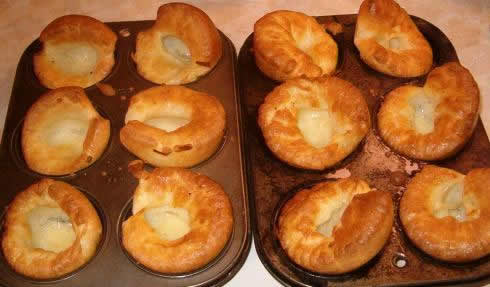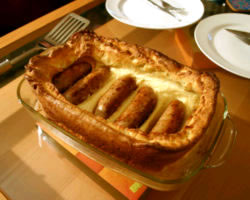Ez egy Nyelvelemzés (Language Analysis) típusú feladat. Itt van hozzá a használati utasítás.

Yorkshire pudding is a dish made from batter. It is most often served with roast beef, chicken, or any meat in which there is gravy, or on its own. Gravy is considered an essential accompaniment by many, and when the pudding is eaten as a starter, onion gravy is usually favoured. It may have originated in Yorkshire, but is popular across the whole of the United Kingdom. It is often claimed that the purpose of the dish was to provide a cheap way to fill the diners, because the Yorkshire pudding is much cheaper than the other constituents of the meal – as the Yorkshire pudding was traditionally served first.
Yorkshire pudding is cooked by pouring batter into a preheated greased baking tin containing very hot oil and baking at very high heat until it has risen.
Traditionally, it is cooked in a large tin underneath a roasting joint of meat in order to catch the dripping fat. Yorkshire pudding may also be made in the same pan as the meat, after the meat has been cooked and moved to a serving plate. It is not uncommon to cook them in muffin tins, using 2 or more tablespoons of batter per muffin, with 1-2 tablespoons of oil in each tin before preheating the pan to very hot. Today, individual round puddings baked in baking tins are increasingly prevalent, and can be bought frozen.
The Yorkshire pudding is a staple food of the British Sunday dinner and in some cases is eaten as a separate course prior to the main meat dish. This was the traditional method of eating the pudding and is still common today. Because the rich gravy from the roast meat drippings was used up with the first course, the main meat and vegetable course was often served with a parsley or white sauce.
When baked with sausages within the batter, it is known as toad in the hole. In pub cuisine, Yorkshire puddings may be offered with a multitude of fillings, with the pudding acting as a bowl. The pudding can also be eaten as a sweet dish, with jam, golden syrup, or sugar.
Based on Wikipedia
batter: nincs rá magyar szó, de a palacsintatészta egészen közeli, hiszen lisztből, tojásból és tejből csinálják.
gravy: ez sem fordítható egyenesben magyarra. Mártás, amit húsokhoz adnak.
on its own: magában, egyedül. A szerkezet: on one’s own
accompaniment: tartozék, járulék, ami hozzá jár. to accompnay: – kísér, vele megy
starter: előétel
something is favoured: azt szeretik jobban, arra esik a választás
to originate somewhere: valahonnan ered. Ügyelj a vonzatra, nem ból/ből!
may have originated: lehet, hogy onnana ered – a may segédige múltra vonatkozik, ezért az ige perfect alakban van
the whole of the: az egész… lehetne még: all the UK, de vigyázz, melyiknél hol van névelő!!!
It is often claimed: szó szerint: gyakran azt állítják – vagyis sokak szerint. Gyakori szerkezet.
as the Yorkshire pudding was traditionally served first: az as fontos itt – kötőszó: mivelhogy. Tehát: mivel a YP-ot rendszerint először tálalták fel.
baking tin: így hívjuk a tepsit, meg minden más sütőformát, amit sütőbe teszünk
until it has risen: (rise, rose, risen) amíg meg nem duzzad, fel nem emelkedik. Present perfect, mert az eredménye a mondandó lényege: fel van emelkedve
joint of meat: nem fordítható egyenesben magyarra. Egy nagyobb darab, egyben sült hús
serving plate: tálalóedény, a tálalásra szolgáló tányér
It is not uncommon to: Az sem ritka, hogy… – gyakori kifejezés, magold be!
muffin: ma már nálunk is ismert dolog, magyarul is muffinnak monduuk (bár angolul a-val ejtjük persze), kis, kerek édes süteményféle
tablespoon: evőkanál. Receptekben mindig rövidítve szerepel: tbs
prevalent: gyakori, mindenütt elődforuló, hétköznapi
staple food: alapélelmiszer – de stílusban ennél sokkal hétköznapibb. Magyar szót stílusban nem nagyon lehet taláni rá.
separate course: különálló fogás
white sauce: besamelmártás (lisztből, vajból és tejből készül)
toad-in-the-hole: szó szerint varangyosbéka a lyukban. A név történetét nem ismerjük, az ételt magát a szövegben ismerheted meg. Így néz ki:

A feladathoz kapcsolódik egy gap-filling feladat is.
Ha kérdést tennél fel vagy ha megvitatnál valamit az anyaggal kapcsolatban, használd a fórumot!

